The scimitar-horned oryx (Oryx dammah), named for its distinctive, curved horns that resemble a scimitar sword. It is an antelope native to the arid regions of North Africa. Known for its striking appearance and incredible adaptations to desert life, this species has a rich history intertwined with human culture and environmental changes. Once abundant across the Saharan landscape, the scimitar-horned oryx faced dramatic population declines due to overhunting, habitat loss, and climate change, leading to its declaration as extinct in the wild by the 1980s. However, recent conservation efforts have sparked hope for the species’ resurgence in its natural habitat.
Historical Context and Extinction
The scimitar-horned oryx once roamed in vast herds across the Sahel and Sahara, from Morocco to Egypt. Historical accounts from ancient civilizations, including Egyptian art and folklore, depict the oryx as a symbol of beauty and resilience. Its striking white coat with a reddish-brown neck, and long, symmetrical horns made it a prized target for hunters. As the 20th century progressed, the combination of increased hunting, often from motorized vehicles and firearms, and habitat degradation due to agricultural expansion and desertification, critically reduced their numbers.
By the 1970s, the population of scimitar-horned oryx had plummeted to the brink of extinction. Conservationists sounded alarms, but despite captive breeding efforts, the last wild oryx lived in the 1980s. In 2000, the International Union for Conservation of Nature (IUCN) declared the scimitar-horned oryx extinct in the wild.

Biological and Ecological Characteristics
The scimitar-horned oryx is uniquely adapted to survive in harsh desert environments. They can endure extreme heat and prolonged periods without water by deriving moisture from their food and conserving bodily fluids. Their kidneys are highly efficient, allowing them to excrete concentrated urine, minimizing water loss. These antelopes are predominantly grazers, feeding on grasses, herbs, and the occasional shrub. Their social structure consists of herds that can range from a few individuals to several dozen.
The oryx’s reproductive strategy is geared towards ensuring the survival of offspring in an unforgiving environment. Females give birth to a single calf after a gestation period of approximately eight and a half months. Calves are hidden for the first few weeks of life to protect them from predators, after which they join the herd.
Conservation Efforts and Reintroduction
The dramatic decline of the scimitar-horned oryx prompted international conservation efforts focusing on captive breeding and reintroduction. Zoos and wildlife reserves around the world established breeding programs aimed at creating a genetically diverse population that will help to reintroduce them into the wild.
A significant turning point came with the Sahara Conservation Fund (SCF) and the Environment Agency – Abu Dhabi (EAD), which spearheaded ambitious rewilding projects. In 2016, after extensive planning and coordination with local governments and communities, a group of captive-bred oryx was released into the Ouadi Rimé-Ouadi Achim Game Reserve in Chad. This project marked the first step towards re-establishing a wild population.
The reintroduction efforts have faced numerous challenges, including ensuring the oryx adapt to their new environment, monitoring their health, and protecting them from poaching. However, the project has shown promising results, with released animals forming herds, reproducing, and demonstrating natural behaviors.
Cultural and Ecological Significance
The return of the scimitar-horned oryx to its native habitat is not only a triumph of conservation but also a restoration of a key species within the Saharan ecosystem. As a herbivore, the oryx plays a crucial role in maintaining the balance of the desert environment. Their grazing habits help control vegetation, which can prevent the overgrowth that leads to wildfires and ensures a balanced ecosystem for other wildlife.
Culturally, the scimitar-horned oryx holds a special place in the heritage of the Sahara’s indigenous people. Their reintroduction is a restoration of an emblematic species that has been part of human folklore and history for millennia. Communities involved in the reintroduction projects have shown significant support, as the oryx is not just an animal but a symbol of resilience and cultural identity.
Future Prospects
The future of the scimitar-horned oryx in the wild remains cautiously optimistic. Continued success depends on sustained conservation efforts, ongoing monitoring, and addressing threats such as poaching and climate change. Building on the initial successes, conservationists aim to expand reintroduction programs to other suitable habitats within the oryx’s historical range.
Collaborations between governments, conservation organizations, and local communities will be crucial in ensuring the long-term viability of these projects. Educational campaigns and community involvement are essential to foster a sense of stewardship and protection for the oryx and its habitat.
Conclusion
The story of the scimitar-horned oryx is a testament to both the fragility and resilience of nature. From the brink of extinction to a hopeful resurgence in its native habitat, the journey of the oryx underscores the importance of conservation and the positive impact of collaborative efforts. So, as these magnificent creatures once again roam the deserts of North Africa, they bring with them a message of hope and the enduring power of restoration.









